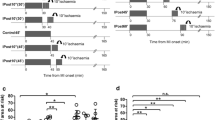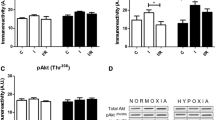Abstract
Ischemic postconditioning (IPost) has been demonstrated to reduce myocardial injury in patients undergoing primary coronary angioplasty for an acute myocardial infarction.Pre-clinical animal studies suggest that pro-survival protein kinases of the Reperfusion Injury Salvage Kinase (RISK) pathway such as Akt and Erk1/2 mediate the cardioprotective effect of IPost.Whether IPost can protect human myocardial tissue ex vivo and whether it recruits the RISK pathway in human myocardium are both not known. To investigate this, atrial appendages were harvested from patients undergoing cardiac surgery. From these samples atrial trabeculae were isolated and mounted on a superperfusion apparatus and subjected to 90 min of hypoxia followed by 120 min of reoxygenation at the end of which function expressed as a percentage of the recovery of baseline contractile function was determined.Atrial trabeculae were randomized to control, hypoxic preconditioning (HPre), hypoxic postconditioning comprising either four 30-s (HPost-30) or 60-s (HPost-60) episodes of alternating hypoxia and reoxygenation, and HPost in the presence or absence of UO126 (a MEK1/2 inhibitor) or LY294002 (a PI3K inhibitor).HPre and HPost-60 improved the recovery of baseline contractile function (45.4±3.2% with HPre and 45.2±2.2% with HPost-60 vs 26.7±2.1 % in control: N≥ 6/group: P<0.05), whereas HPost-30 failed to cardioprotect (28.3±3.4% with HPost-30 vs 26.7±2.1 % in control: N≥ 6/group: P>0.05). The cardioprotective effect of HPost-60 was abolished in the presence of either LY (28.1±2.5% with HPost-60+LY vs 45.2±2.2% with HPost-60: N≥ 6/group: P<0.05) or UO (32.7±1.8% with HPost-60+UO vs 45.2±2.2% with HPost-60:N=7/group: P<0.05). The kinase inhibitors alone had no effect on functional recovery (28.2±3.6% with LY and 30.1±4.8% with UO vs 26.7±2.1 % in control: N≥ 5/group: P>0.05). In conclusion, we demonstrate for the first time that postconditioning protects human myocardium ex vivo and that this effect is dependent on the activation of the RISK pathway.
Similar content being viewed by others
References
Bopassa JC, Ferrera R, Gateau-Roesch O,Couture-Lepetit E,Ovize M (2006) PI 3-kinase regulates the mitochondrial transition pore in controlled reperfusion and postconditioning. Cardiovasc Res 69:178–185
Braunwald E, Kloner RA (1985) Myocardial reperfusion: a double-edged sword? J Clin Invest 76:1713–1719
Carr CS, Grover GJ, Pugsley WB,Yellon DM (1997) Comparison of the protective effects of a highly selective ATPsensitive potassium channel opener and ischemic preconditioning in isolated human atrial muscle. Cardiovasc Drugs Ther 11:473–478
Carr CS,Hill RJ,Masamune H,Kennedy SP, Knight DR, Tracey WR, Yellon DM (1997) Evidence for a role for both the adenosine A1 and A3 receptors in protection of isolated human atrial muscle against simulated ischaemia. Cardiovasc Res 36:52–59
Carr CS, Yellon DM (1997) Ischaemic preconditioning may abolish the protection afforded by ATP-sensitive potassium channel openers in isolated human atrial muscle. Basic Res Cardiol 92:252–260
Darling CE, Solari PB, Smith CS, Furman MI, Przyklenk K (2007) ‘Postconditioning’ the human heart: Multiple balloon inflations during primary angioplasty may confer cardioprotection. Basic Res Cardiol 102(3):274–278
Darling CE, Jiang R,Maynard M,Whittaker P,Vinten-Johansen J, Przyklenk K (2005) ‘Postconditioning’ via stuttering reperfusion limits myocardial infarct size in rabbit hearts: Role of ERK 1/2. Am J Physiol Heart Circ Physiol 289(4):H1618–26
Davidson SM, Hausenloy D, Duchen MR,Yellon DM (2005) Signalling via the reperfusion injury signalling kinase (RISK) pathway links closure of the mitochondrial permeability transition pore to cardioprotection. Int J Biochem Cell Biol 38:414–419
Fujita M,Asanuma H,Hirata A,Wakeno M, Takahama H, Sasaki H, Kim J, Takashima S, Tsukamoto O, Minamino T, Shinozaki Y, Tomoike H, Hori M, Kitakaze M (2007) Prolonged transient acidosis during early reperfusion contributes to the cardioprotective effects of postconditioning. Am J Physiol Heart Circ Physiol 292:H2004–H2008
Hausenloy DJ, Yellon DM (2007) Preconditioning and postconditioning: United at reperfusion.Pharmacol Therapeutics (in press)
Hausenloy DJ, Tsang A, Yellon DM (2005) The reperfusion injury salvage kinase pathway: a common target for both ischemic preconditioning and postconditioning. Trends Cardiovasc Med 15:69–75
Hausenloy DJ, Yellon DM (2003) The mitochondrial permeability transition pore: its fundamental role in mediating cell death during ischaemia and reperfusion. J Mol Cell Cardiol 35:339–341
Hausenloy DJ, Yellon DM (2004) New directions for protecting the heart against ischaemia-reperfusion injury: targeting the Reperfusion Injury Salvage Kinase (RISK)-pathway. Cardiovasc Res 61:448–460
Heusch G (2004) Postconditioning: old wine in a new bottle? J Am Coll Cardiol 44:1111–1112
Heusch G,Buchert A,Feldhaus S,Schulz R (2006) No loss of cardioprotection by postconditioning in connexin 43-deficient mice. Basic Res Cardiol 101:354–356
Iliodromitis EK, Georgiadis M, Cohen MV,Downey JM, Bofilis E,Kremastinos DT (2006) Protection from postconditioning depends on the number of short ischemic insults in anesthetized pigs. Basic Res Cardiol 101:502–507
Jiang X, Shi E,Nakajima Y, Sato S (2006) Postconditioning,a series of brief interruptions of early reperfusion, prevents neurologic injury after spinal cord ischemia. Ann Surg 244:148–153
Juhaszova M,Zorov DB,Kim SH,Pepe S, Fu Q, Fishbein KW, Ziman BD,Wang S, Ytrehus K, Antos CL, Olson EN, Sollott SJ (2004) Glycogen synthase kinase- 3beta mediates convergence of protection signaling to inhibit the mitochondrial permeability transition pore. J Clin Invest 113:1535–1549
Kin H, Zatta AJ, Lofye MT,Amerson BS, Halkos ME,Kerendi F,Zhao ZQ,Guyton RA, Headrick JP, Vinten-Johansen J (2005) Postconditioning reduces infarct size via adenosine receptor activation by endogenous adenosine. Cardiovasc Res 67:124–133
Laskey WK (2005) Brief repetitive balloon occlusions enhance reperfusion during percutaneous coronary intervention for acute myocardial infarction: a pilot study. Catheter Cardiovasc Interv 65:361–367
Ma X, Zhang X, Li C, Luo M (2006) Effect of postconditioning on coronary blood flow velocity and endothelial function and LV recovery after myocardial infarction. J Interv Cardiol 19:367–375
Mudalagiri NR, Yellon DM (2006) Erythropoietin-mediated protection against hypoxia/reoxygenation injury in human muscle is via phosphatidylinositol- 3-kinase and P44/P42 kinase activation. Circulation 114(18), Abstract
Shanmuganathan S, Hausenloy DJ, Duchen MR, Yellon DM (2005) Mitochondrial permeability transition pore as a target for cardioprotection in the human heart. Am J Physiol Heart Circ Physiol 289:H237-H242
Speechly-Dick ME, Grover GJ, Yellon DM (1995) Does ischemic preconditioning in the human involve protein kinase C and the ATP-dependent K+ channel? Studies of contractile function after simulated ischemia in an atrial in vitro model. Circ Res 77:1030–1035
Staat P, Rioufol G, Piot C,Cottin Y,Cung TT, L’Huillier I, Aupetit JF, Bonnefoy E, Finet G,Andre-Fouet X,Ovize M (2005) Postconditioning the human heart. Circulation 112:2143–2148
Sun HY,Wang NP,Kerendi F,Halkos M, Kin H, Guyton RA, Vinten-Johansen J, Zhao ZQ (2005) Hypoxic postconditioning reduces cardiomyocyte loss by inhibiting ROS generation and intracellular Ca2+ overload. Am J Physiol Heart Circ Physiol 288:H1900–H1908
Sun K, Liu ZS, Sun Q (2004) Role of mitochondria in cell apoptosis during hepatic ischemia-reperfusion injury and protective effect of ischemic postconditioning. World J Gastroenterol 10:1934–1938
Tsang A, Hausenloy DJ, Mocanu MM, Yellon DM (2004) Postconditioning: a form of “modified reperfusion” protects the myocardium by activating the phosphatidylinositol 3-kinase-Akt pathway. Circ Res 95:230–232
Tsang A, Hausenloy DJ, Yellon DM (2005) Myocardial postconditioning: reperfusion injury revisited. Am J Physiol Heart Circ Physiol 289:H2–H7
Vinten-Johansen J, Zhao ZQ, Zatta AJ, Kin H, Halkos ME, Kerendi F (2005) Postconditioning A new link in nature’s armor against myocardial ischemiareperfusion injury. Basic Res Cardiol 100:295–310
Walker DM, Walker JM, Pugsley WB, Pattison CW,Yellon DM (1995) Preconditioning in isolated superfused human muscle.J Mol Cell Cardiol 27:1349–1357
Yang XC, Liu Y,Wang LF, Cui L, Ge YG, Wang HS, Li WM, Xu L, Ni ZH, Liu HS, Zhang L, Wang T, Jia HM, Vinten-Johansen J, Zhao ZQ (2006) Permanent reduction in myocardial infarct size by postconditioning in patients after primary coronary angioplasty. Circulation 114(18), II-812,Abstract
Yang XM, Proctor JB, Cui L, Krieg T, Downey JM, Cohen MV (2004) Multiple, brief coronary occlusions during early reperfusion protect rabbit hearts by targeting cell signaling pathways. J Am Coll Cardiol 44:1103–1110
Zhao H, Sapolsky RM, Steinberg GK (2006) Interrupting reperfusion as a stroke therapy: ischemic postconditioning reduces infarct size after focal ischemia in rats. J Cereb Blood Flow Metab 26:1114–1121
Zhao ZQ, Wang NP, Mykytenko J, Reeves J, Deneve J, Jiang R, Zatta AJ, Guyton RA, Vinten-Johansen, J (2006) Postconditioning attenuates cardiac muscle cell apoptosis via translocation of survival kinases and opening of KATP channels in mitochondria. Circulation 114(18), II-261,Abstract
Zhao ZQ, Corvera JS, Halkos ME, Kerendi F, Wang NP, Guyton RA, Vinten- Johansen J (2003) Inhibition of myocardial injury by ischemic postconditioning during reperfusion: comparison with ischemic preconditioning. Am J Physiol Heart Circ Physiol 285:H579–H588
Zhao ZQ, Vinten-Johansen J (2006) Postconditioning: reduction of reperfusion- induced injury. Cardiovasc Res 70:200–211
Author information
Authors and Affiliations
Corresponding author
Rights and permissions
About this article
Cite this article
Sivaraman, V., Mudalgiri, N.R., Di Salvo, C. et al. Postconditioning protects human atrial muscle through the activation of the RISK pathway. Basic Res Cardiol 102, 453–459 (2007). https://doi.org/10.1007/s00395-007-0664-1
Received:
Revised:
Accepted:
Published:
Issue Date:
DOI: https://doi.org/10.1007/s00395-007-0664-1




